Report on Qantas Airways: Leadership, Culture, and Change Dynamics
VerifiedAdded on 2023/06/11
|5
|861
|475
Report
AI Summary
This report provides an analysis of Qantas Airways' organizational culture, highlighting its evolution and the impact of leadership decisions, particularly under Alan Joyce's leadership. It examines the shift from a normative culture to one emphasizing employee communication and inclusion, which aims to enhance employee satisfaction and promote strategic growth. The report further investigates the significant changes Qantas has undergone, including fleet expansion and fare policy adjustments, and identifies the driving forces, such as cost reduction and competitive pressures, as well as restraining forces like legislation and employee resistance, that have shaped the airline's strategic direction and operational changes. The analysis incorporates references to relevant research and industry perspectives to support the findings.
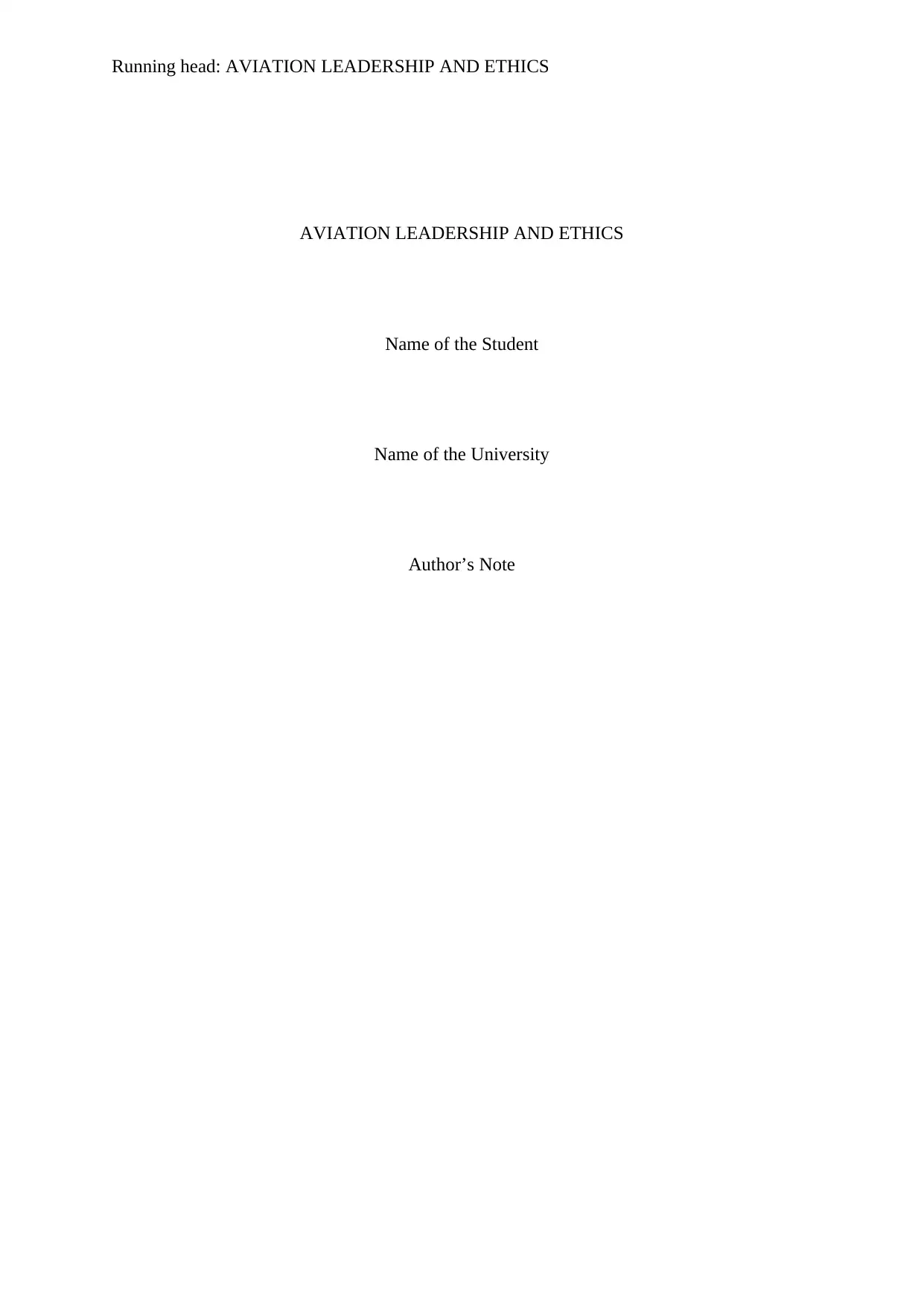
Running head: AVIATION LEADERSHIP AND ETHICS
AVIATION LEADERSHIP AND ETHICS
Name of the Student
Name of the University
Author’s Note
AVIATION LEADERSHIP AND ETHICS
Name of the Student
Name of the University
Author’s Note
Paraphrase This Document
Need a fresh take? Get an instant paraphrase of this document with our AI Paraphraser
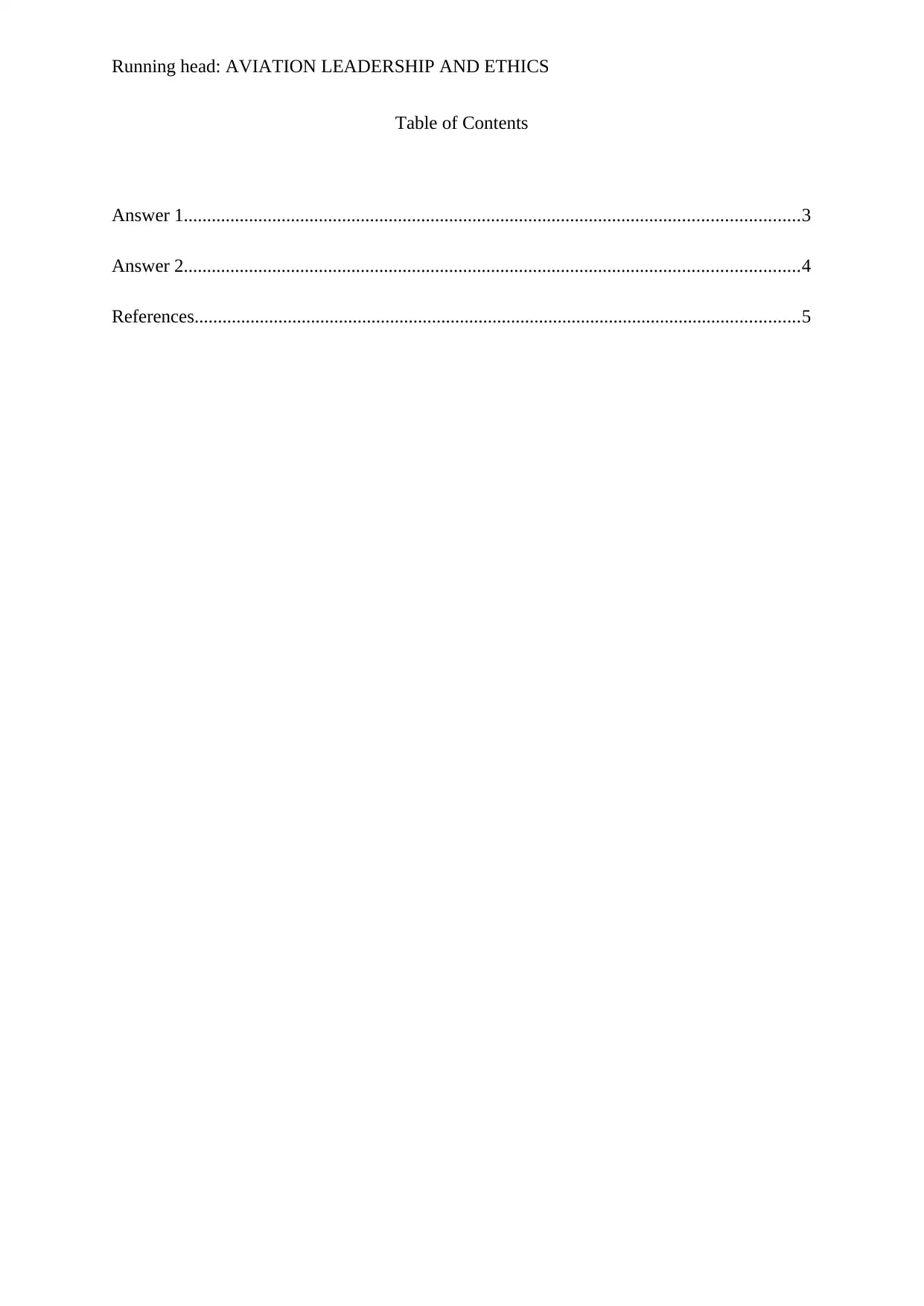
Running head: AVIATION LEADERSHIP AND ETHICS
Table of Contents
Answer 1....................................................................................................................................3
Answer 2....................................................................................................................................4
References..................................................................................................................................5
Table of Contents
Answer 1....................................................................................................................................3
Answer 2....................................................................................................................................4
References..................................................................................................................................5
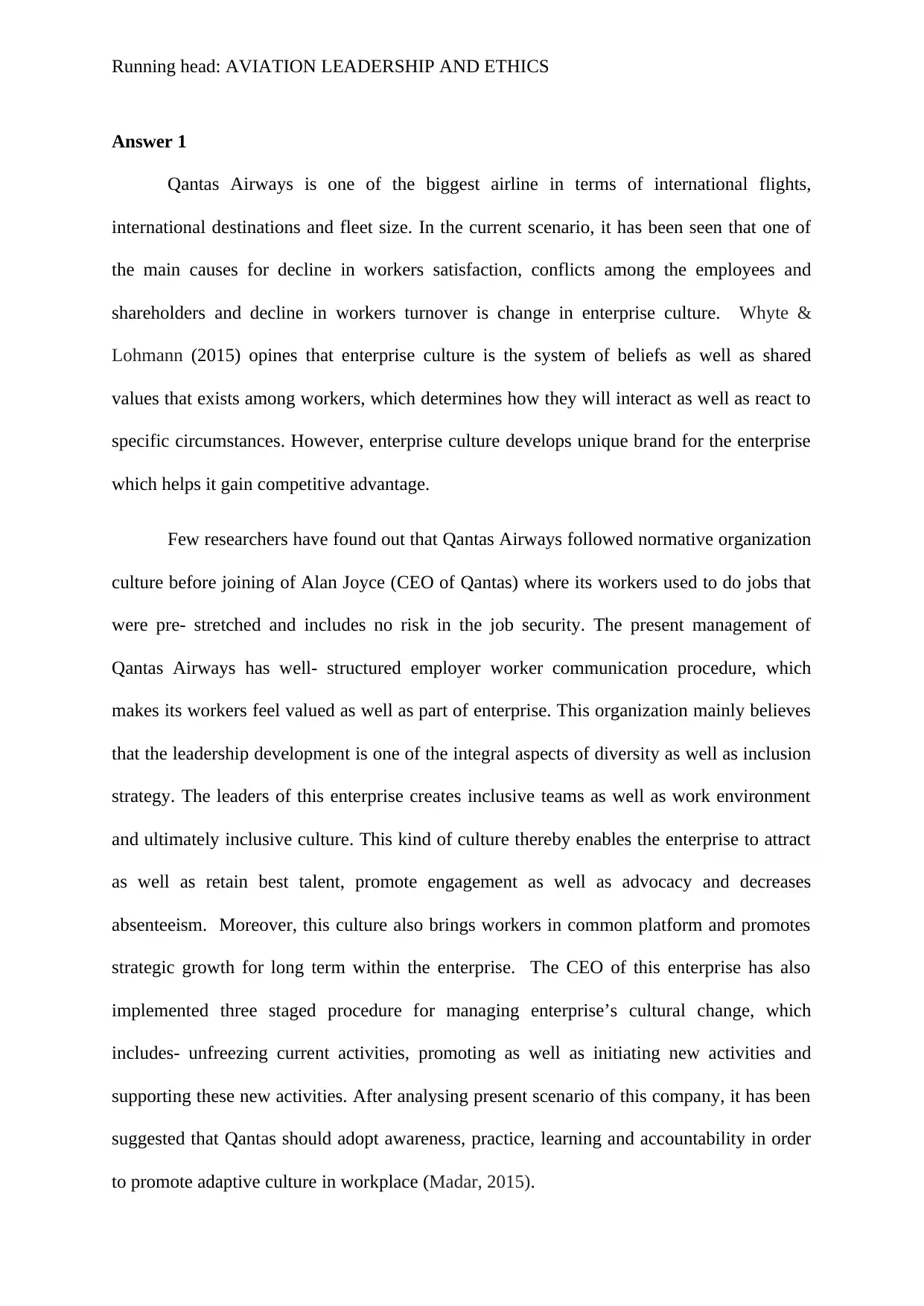
Running head: AVIATION LEADERSHIP AND ETHICS
Answer 1
Qantas Airways is one of the biggest airline in terms of international flights,
international destinations and fleet size. In the current scenario, it has been seen that one of
the main causes for decline in workers satisfaction, conflicts among the employees and
shareholders and decline in workers turnover is change in enterprise culture. Whyte &
Lohmann (2015) opines that enterprise culture is the system of beliefs as well as shared
values that exists among workers, which determines how they will interact as well as react to
specific circumstances. However, enterprise culture develops unique brand for the enterprise
which helps it gain competitive advantage.
Few researchers have found out that Qantas Airways followed normative organization
culture before joining of Alan Joyce (CEO of Qantas) where its workers used to do jobs that
were pre- stretched and includes no risk in the job security. The present management of
Qantas Airways has well- structured employer worker communication procedure, which
makes its workers feel valued as well as part of enterprise. This organization mainly believes
that the leadership development is one of the integral aspects of diversity as well as inclusion
strategy. The leaders of this enterprise creates inclusive teams as well as work environment
and ultimately inclusive culture. This kind of culture thereby enables the enterprise to attract
as well as retain best talent, promote engagement as well as advocacy and decreases
absenteeism. Moreover, this culture also brings workers in common platform and promotes
strategic growth for long term within the enterprise. The CEO of this enterprise has also
implemented three staged procedure for managing enterprise’s cultural change, which
includes- unfreezing current activities, promoting as well as initiating new activities and
supporting these new activities. After analysing present scenario of this company, it has been
suggested that Qantas should adopt awareness, practice, learning and accountability in order
to promote adaptive culture in workplace (Madar, 2015).
Answer 1
Qantas Airways is one of the biggest airline in terms of international flights,
international destinations and fleet size. In the current scenario, it has been seen that one of
the main causes for decline in workers satisfaction, conflicts among the employees and
shareholders and decline in workers turnover is change in enterprise culture. Whyte &
Lohmann (2015) opines that enterprise culture is the system of beliefs as well as shared
values that exists among workers, which determines how they will interact as well as react to
specific circumstances. However, enterprise culture develops unique brand for the enterprise
which helps it gain competitive advantage.
Few researchers have found out that Qantas Airways followed normative organization
culture before joining of Alan Joyce (CEO of Qantas) where its workers used to do jobs that
were pre- stretched and includes no risk in the job security. The present management of
Qantas Airways has well- structured employer worker communication procedure, which
makes its workers feel valued as well as part of enterprise. This organization mainly believes
that the leadership development is one of the integral aspects of diversity as well as inclusion
strategy. The leaders of this enterprise creates inclusive teams as well as work environment
and ultimately inclusive culture. This kind of culture thereby enables the enterprise to attract
as well as retain best talent, promote engagement as well as advocacy and decreases
absenteeism. Moreover, this culture also brings workers in common platform and promotes
strategic growth for long term within the enterprise. The CEO of this enterprise has also
implemented three staged procedure for managing enterprise’s cultural change, which
includes- unfreezing current activities, promoting as well as initiating new activities and
supporting these new activities. After analysing present scenario of this company, it has been
suggested that Qantas should adopt awareness, practice, learning and accountability in order
to promote adaptive culture in workplace (Madar, 2015).
⊘ This is a preview!⊘
Do you want full access?
Subscribe today to unlock all pages.

Trusted by 1+ million students worldwide
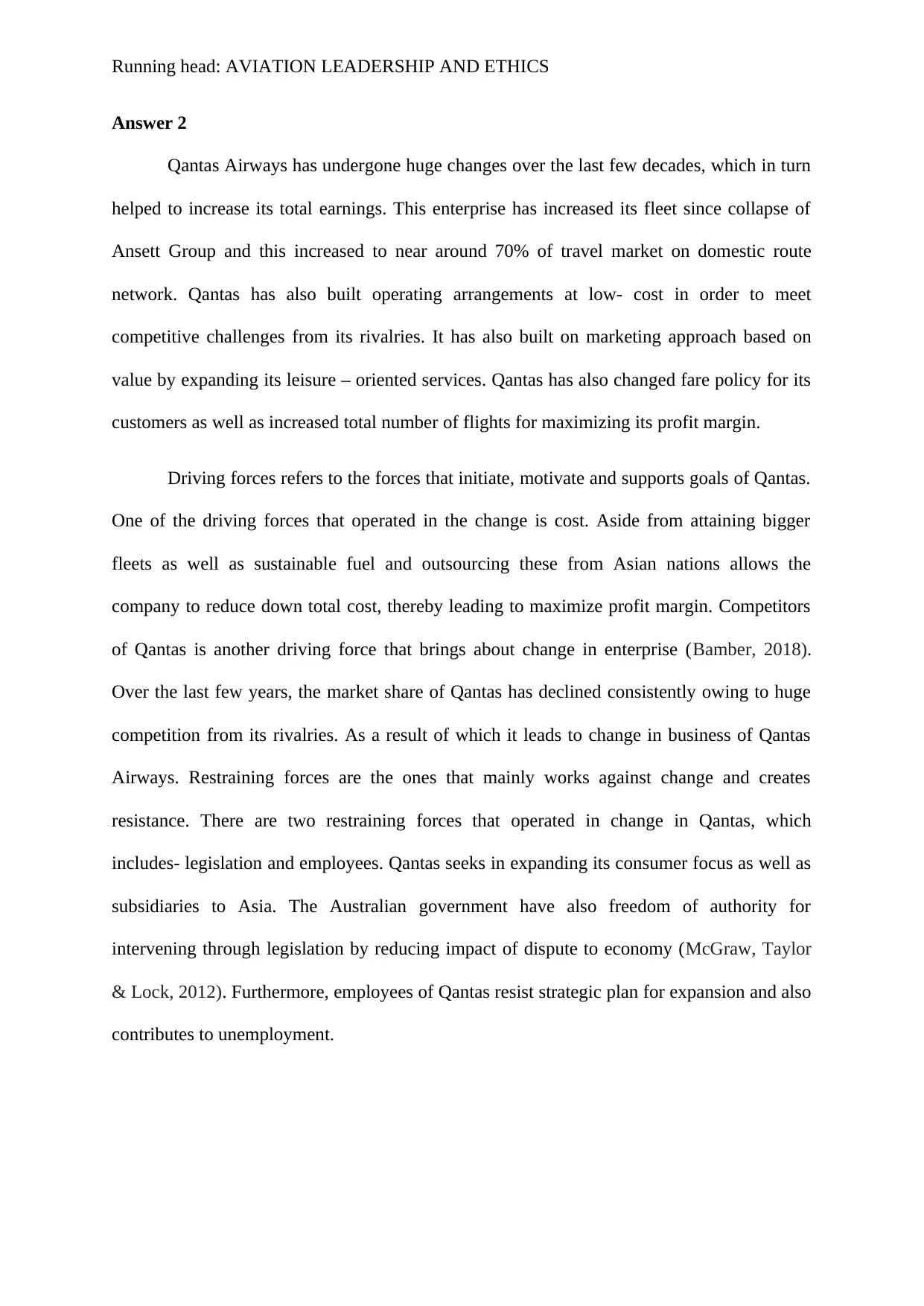
Running head: AVIATION LEADERSHIP AND ETHICS
Answer 2
Qantas Airways has undergone huge changes over the last few decades, which in turn
helped to increase its total earnings. This enterprise has increased its fleet since collapse of
Ansett Group and this increased to near around 70% of travel market on domestic route
network. Qantas has also built operating arrangements at low- cost in order to meet
competitive challenges from its rivalries. It has also built on marketing approach based on
value by expanding its leisure – oriented services. Qantas has also changed fare policy for its
customers as well as increased total number of flights for maximizing its profit margin.
Driving forces refers to the forces that initiate, motivate and supports goals of Qantas.
One of the driving forces that operated in the change is cost. Aside from attaining bigger
fleets as well as sustainable fuel and outsourcing these from Asian nations allows the
company to reduce down total cost, thereby leading to maximize profit margin. Competitors
of Qantas is another driving force that brings about change in enterprise (Bamber, 2018).
Over the last few years, the market share of Qantas has declined consistently owing to huge
competition from its rivalries. As a result of which it leads to change in business of Qantas
Airways. Restraining forces are the ones that mainly works against change and creates
resistance. There are two restraining forces that operated in change in Qantas, which
includes- legislation and employees. Qantas seeks in expanding its consumer focus as well as
subsidiaries to Asia. The Australian government have also freedom of authority for
intervening through legislation by reducing impact of dispute to economy (McGraw, Taylor
& Lock, 2012). Furthermore, employees of Qantas resist strategic plan for expansion and also
contributes to unemployment.
Answer 2
Qantas Airways has undergone huge changes over the last few decades, which in turn
helped to increase its total earnings. This enterprise has increased its fleet since collapse of
Ansett Group and this increased to near around 70% of travel market on domestic route
network. Qantas has also built operating arrangements at low- cost in order to meet
competitive challenges from its rivalries. It has also built on marketing approach based on
value by expanding its leisure – oriented services. Qantas has also changed fare policy for its
customers as well as increased total number of flights for maximizing its profit margin.
Driving forces refers to the forces that initiate, motivate and supports goals of Qantas.
One of the driving forces that operated in the change is cost. Aside from attaining bigger
fleets as well as sustainable fuel and outsourcing these from Asian nations allows the
company to reduce down total cost, thereby leading to maximize profit margin. Competitors
of Qantas is another driving force that brings about change in enterprise (Bamber, 2018).
Over the last few years, the market share of Qantas has declined consistently owing to huge
competition from its rivalries. As a result of which it leads to change in business of Qantas
Airways. Restraining forces are the ones that mainly works against change and creates
resistance. There are two restraining forces that operated in change in Qantas, which
includes- legislation and employees. Qantas seeks in expanding its consumer focus as well as
subsidiaries to Asia. The Australian government have also freedom of authority for
intervening through legislation by reducing impact of dispute to economy (McGraw, Taylor
& Lock, 2012). Furthermore, employees of Qantas resist strategic plan for expansion and also
contributes to unemployment.
Paraphrase This Document
Need a fresh take? Get an instant paraphrase of this document with our AI Paraphraser
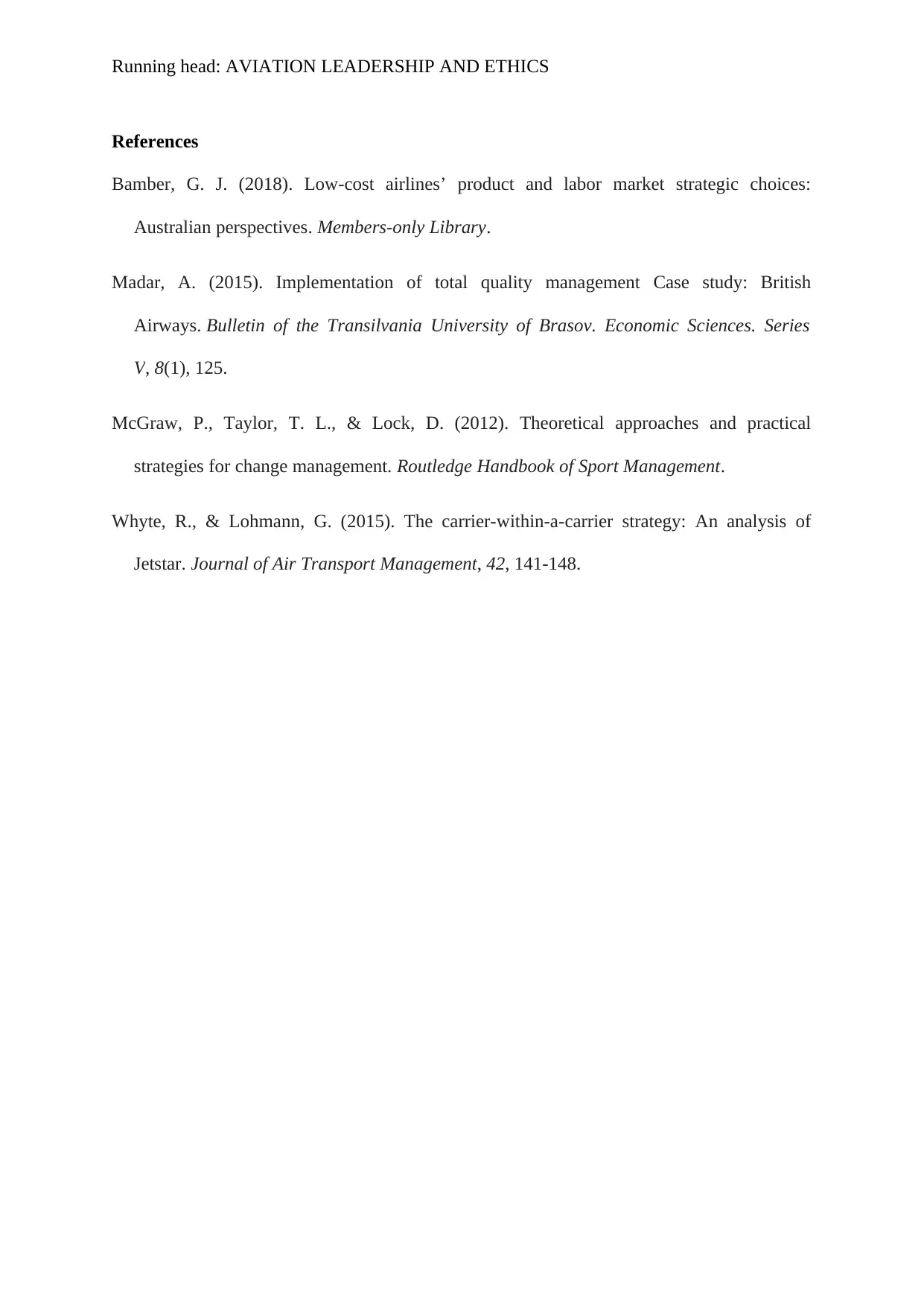
Running head: AVIATION LEADERSHIP AND ETHICS
References
Bamber, G. J. (2018). Low-cost airlines’ product and labor market strategic choices:
Australian perspectives. Members-only Library.
Madar, A. (2015). Implementation of total quality management Case study: British
Airways. Bulletin of the Transilvania University of Brasov. Economic Sciences. Series
V, 8(1), 125.
McGraw, P., Taylor, T. L., & Lock, D. (2012). Theoretical approaches and practical
strategies for change management. Routledge Handbook of Sport Management.
Whyte, R., & Lohmann, G. (2015). The carrier-within-a-carrier strategy: An analysis of
Jetstar. Journal of Air Transport Management, 42, 141-148.
References
Bamber, G. J. (2018). Low-cost airlines’ product and labor market strategic choices:
Australian perspectives. Members-only Library.
Madar, A. (2015). Implementation of total quality management Case study: British
Airways. Bulletin of the Transilvania University of Brasov. Economic Sciences. Series
V, 8(1), 125.
McGraw, P., Taylor, T. L., & Lock, D. (2012). Theoretical approaches and practical
strategies for change management. Routledge Handbook of Sport Management.
Whyte, R., & Lohmann, G. (2015). The carrier-within-a-carrier strategy: An analysis of
Jetstar. Journal of Air Transport Management, 42, 141-148.
1 out of 5
Related Documents
Your All-in-One AI-Powered Toolkit for Academic Success.
+13062052269
info@desklib.com
Available 24*7 on WhatsApp / Email
![[object Object]](/_next/static/media/star-bottom.7253800d.svg)
Unlock your academic potential
Copyright © 2020–2025 A2Z Services. All Rights Reserved. Developed and managed by ZUCOL.




